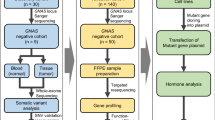Abstract
It is estimated that up to one in five individuals develops pituitary gland tumors, despite the common occurrence of these tumors, the pathogenetic mechanisms underlying their development mainly remain unknown. We studied the gene expression in null cell adenomas compared with normal pituitary by expressed sequence tags (EST) sequencing and cDNA microarray on large scale. Both approaches of EST sequencing and microarray analysis showed that 17 genes were differentially expressed in human null cell pituitary adenoma tissues, among which 14 genes were overexpressed and three genes were underpressed. Five of the genes with potential oncogenic significance by RT-real time quantitative PCR. Synaptotagmin (SYT) are integral membrane proteins of synaptic vesicles considered to serve as Ca2+ sensors in the process of vesicular trafficking and exocytosis. Calcium binding to participates in triggering neurotransmitter release at the synapse. In view of our finding that SYT is overexpressed in null cell adenomas, these tumors may be capable of secreting some unknown hormones or peptides. ATP5B and MDH1 were involved in the energy metabolism, whose overexpression in null cell adenomas provide us with a new perspective of exploring the oncogenesis of these tumors. All of these data may contribute to the understanding of null cell adenoma formation and development.





Similar content being viewed by others
References
Melmed S (2003) Mechanisms for pituitary tumorigenesis: the plastic pituitary. J Clin Invest 112:1603–1618
Hu RM, Han ZG, Song HD, Peng YD, Huang QH, Ren SX, Gu YJ, Huang CH, Li YB, Jiang CL, Fu G, Zhang QH, Gu BW, Dai M, Mao YF, Gao GF, Rong R, Ye M, Zhou J, Xu SH, Gu J, Shi JX, Jin WR, Zhang CK, Wu TM, Huang GY, Chen Z, Chen MD, Chen JL (2000) Gene expression profiling in the human hypothalamus-pituitary-adrenal axis and full-length cDNA cloning. Proc Natl Acad Sci USA 97:9543–9548
Wang XC, Xu SY, Wu XY, Song HD, Mao YF, Fan HY, Yu F, Mou B, Gu YY, Xu LQ, Zhou XO, Chen Z, Chen JL, Hu RM (2004) Gene expression profiling in human insulinoma tissue: genes involved in the insulin secretion pathway and cloning of novel full-length cDNAs. Endocr Relat Cancer 11:295–303
Kovacs K, Horvath E, Vidal S (2001) Classification of pituitary adenomas. J Neuro-Oncol 54:121–127
Poskanzer KE, Marek KW, Sweeney ST, Davis GW (2003) Synaptotagmin I is necessary for compensatory synaptic vesicle endocytosis in vivo. Nature 426:559–563
Fernandez-Chacon R, Konigstorfer A, Gerber SH, Garcia J, Matos MF, Stevens CF, Brose N, Rizo J, Rosenmund C, Sudhof TC (2001) Synaptotagmin I functions as a calcium regulator of release probability. Nature 410:41–49
Neckelmann N, Warner CK, Chung A, Kudoh J, Minoshima S, Fukuyama R, Maekawa M, Shimizu Y, Shimizu N, Liu JD (1989) The human ATP synthase beta subunit gene: sequence analysis, chromosome assignment, and differential expression. Genomics 5:829–843
Das B, Mondragon MO, Sadeghian M, Hatcher VB, Norin AJ (1994) A novel ligand in lymphocyte-mediated cytotoxicity: expression of the/3 subunit of H+ transporting ATP synthase on the surface of tumor cell lines. J Exp Med 180:273–281
Tanaka T, Inazawa J, Nakamura Y (1996) Molecular cloning and mapping of a human cDNA for cytosolic malate dehydrogenase (MDH1). Genomics 32:128–130
Acknowledgements
The study was funded by grants to RenMing Hu from the Key Project of National Natural Science Foundation of China (30230380), the National Natural Science Foundation of China (39900072), the Chinese High Tech Program (2002BA711A05 and 2001AA221201), the National Key Basic Research and Development Program (2002CB713703) and the Shanghai Commission for Science and Technology (01JC14026). The work was also funded by a grant to Xuanchun Wang from the National Natural Science Foundation of China (30300162).
Author information
Authors and Affiliations
Corresponding author
Rights and permissions
About this article
Cite this article
Hu, J., Song, H., Wang, X. et al. Gene expression profiling in human null cell pituitary adenoma tissue. Pituitary 10, 47–52 (2007). https://doi.org/10.1007/s11102-007-0008-z
Published:
Issue Date:
DOI: https://doi.org/10.1007/s11102-007-0008-z




